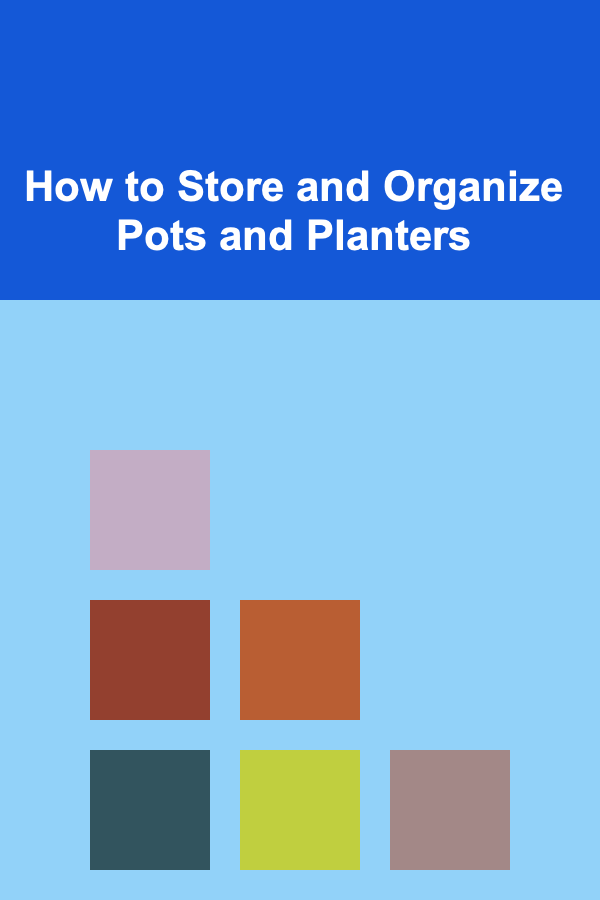
How to Store and Organize Pots and Planters
ebook include PDF & Audio bundle (Micro Guide)
$12.99$5.99
Limited Time Offer! Order within the next:

Gardening is a fulfilling hobby that brings joy, beauty, and health benefits to many. However, as your collection of pots and planters grows, so does the challenge of organizing and storing them efficiently. Whether you are an avid gardener or just starting, understanding how to store and organize your pots and planters can save you time, space, and frustration. This comprehensive guide aims to provide practical strategies and creative solutions for effectively organizing your gardening supplies.
Understanding the Importance of Organization
Efficiency and Accessibility
An organized storage system allows you to find what you need quickly. Instead of sifting through stacks of disorganized pots, you can easily access the right planter for your project, saving time and boosting productivity.
Maximizing Space
Gardening often involves working with limited space. A well-organized setup helps you make the most of your available area, ensuring you can store more items while keeping them easily accessible.
Protecting Your Investment
Pots and planters can be expensive. Proper organization can help protect these items from damage, prolonging their lifespan and maintaining their appearance.
Aesthetic Appeal
An organized gardening area not only looks good but can also inspire creativity. A visually appealing workspace makes gardening more enjoyable, encouraging you to spend more time nurturing your plants.
Assessing Your Collection of Pots and Planters
Before diving into organization strategies, it's essential to evaluate your existing collection.
2.1 Inventorying Your Pots and Planters
Start by taking stock of all your pots and planters. Create a list or spreadsheet that includes:
- Type: Ceramic, plastic, metal, biodegradable, etc.
- Size: Small, medium, large, extra-large.
- Condition: New, used, needs repair.
This inventory provides a clear picture of what you have and will guide your organization efforts.
2.2 Categorizing by Size and Type
Once you have a complete inventory, categorize your pots and planters based on size and type. This categorization might include:
- Small Planters: For seedlings and small plants.
- Medium Pots: For herbs and smaller flowering plants.
- Large Containers: For shrubs, larger flowers, or vegetable plants.
- Specialty Pots: Hanging planters, self-watering pots, etc.
Having categories makes it easier to determine how much space you'll need for storage.
Choosing the Right Storage Solutions
With your inventory and categories in hand, it's time to choose suitable storage solutions.
3.1 Shelving Units
Shelving units are an excellent option for storing pots and planters. They can accommodate various sizes and allow for easy visibility.
-
Benefits:
- Maximize vertical space.
- Provide sturdy support for heavier pots.
-
Tips:
- Choose adjustable shelving to accommodate different heights.
- Use shelves at comfortable heights for easy access.
3.2 Bins and Containers
Utilizing bins and containers can help keep pots organized within designated areas.
-
Benefits:
- Keeps smaller pots contained and prevents clutter.
- Stackable options can optimize space.
-
Tips:
- Use clear bins for visibility of contents.
- Label each bin for quick identification of pot types.
3.3 Hanging Systems
Hanging systems can free up floor space by utilizing wall areas.
-
Benefits:
- Ideal for small pots or planters.
- Adds aesthetic appeal to your garden area.
-
Tips:
- Consider using pegboards, hooks, or rail systems.
- Ensure that the hanging system can support the weight of the pots.
3.4 Vertical Gardens
If you're short on horizontal space, vertical gardening solutions can work double duty by providing storage and planting space.
-
Benefits:
- Saves ground space.
- Can serve as a beautiful display.
-
Tips:
- Use tiered plant stands or wall-mounted planters.
- Consider repurposing old pallets or wooden crates.
Creative Organization Techniques
Now that you have chosen your storage solutions, consider implementing these creative techniques to enhance your organization further.
4.1 Labeling Systems
Labels can significantly improve efficiency in locating pots and planters.
-
Benefits:
- Quick identification reduces search time.
- Labels help maintain organization over time.
-
Tips:
- Use waterproof labels for outdoor settings.
- Consider using a label maker for uniformity.
4.2 Color-Coding
Color-coding pots and storage areas can offer a visual cue for organization.
-
Benefits:
- Makes finding specific pots quicker.
- Adds a decorative element to your storage space.
-
Tips:
- Assign colors based on plant types or sizes.
- Use colored tape or stickers to mark bins or shelves.
4.3 Using Clear Containers
Clear containers allow you to see what's inside without opening them.
-
Benefits:
- Reduces time spent searching for specific pots.
- Helps maintain organization by making it easy to spot empty spaces.
-
Tips:
- Opt for containers made from durable materials.
- Ensure lids fit securely if stacking is required.
Storing Pots for Seasonal Changes
Different seasons may require adjustments to your organization strategy.
5.1 Preparing for Winter
In colder months, protecting your pots and planters becomes essential.
- Insulate: Wrap ceramic or terracotta pots in bubble wrap to prevent cracking from freezing temperatures.
- Store Indoors: If possible, bring sensitive plants indoors and store pots in a sheltered area.
- Clean: Before putting pots away, clean them to avoid disease transmission to indoor plants.
5.2 Spring and Summer Organization
As gardening season kicks off, ensure everything is easily accessible.
- Easy Access: Place frequently used pots closest to your work area.
- Grouping by Use: Keep herb pots, vegetable pots, and flower pots together for quick assembly.
5.3 Fall Preparations
In fall, prepare your pots for seasonal changes:
- Inspect for Damage: Check pots for cracks and wear before storing.
- Clean Thoroughly: Remove any soil remnants and debris to prevent pests.
Maintaining an Organized Space
Once you've organized your pots and planters, maintaining that organization is key.
Regular Clean-Ups
Schedule regular clean-ups, ideally at the beginning of each season. This practice will help prevent clutter from accumulating again.
Reassess Storage Solutions
As your collection grows or changes, reassess your storage solutions. Adjust layouts or bins to accommodate new pots and planters.
Encouraging Good Habits
Encourage anyone who uses the space to put things back where they belong. Establish rules for returning pots to their designated areas after use.
Common Mistakes to Avoid
Avoid these common pitfalls when organizing pots and planters:
Overcrowding Storage Areas
Avoid cramming too many items into one space, which can lead to breakage or chaos. Leave enough room for easy access and visibility.
Neglecting Maintenance
Failing to regularly clean and maintain your storage area can lead to a decline in organization. Make maintenance a regular habit.
Ignoring Conditions
Consider the conditions where you store your pots. Ensure they are protected from elements like direct sunlight, moisture, or extreme temperatures that could cause damage.
Conclusion
Organizing pots and planters is essential for any gardener looking to maximize efficiency, protect their investments, and create an aesthetically pleasing workspace. By assessing your collection, choosing suitable storage solutions, and implementing creative organizational techniques, you can create a system that works for you year-round.
Regular maintenance, reassessment of your strategies, and avoiding common mistakes will ensure that your gardening space remains organized and efficient. Embrace the satisfaction that comes from a well-kept gardening area, and enjoy the benefits of streamlined processes that allow you to focus on what truly matters---nurturing your plants!
Reading More From Our Other Websites
- [Organization Tip 101] How to Keep Pet Food Fresh and Organized
- [Horseback Riding Tip 101] Saddling Techniques for Different Riding Disciplines: Dressage, Trail, and Western
- [Rock Climbing Tip 101] The Science of Grip: How to Build Finger Strength for Better Climbing
- [Mindful Eating Tip 101] Best Mindful Eating Guidelines for Parents Teaching Kids About Food
- [Home Budget Decorating 101] How to Decorate Your Home on a Tight Budget Without Compromising Style
- [Reading Habit Tip 101] Mind-Mapping Your Books: A Visual Guide to Locking in What You Read
- [Home Staging 101] How to Stage Your Home for Luxury Appeal
- [Personal Investment 101] How to Use Asset Allocation to Reduce Investment Risk
- [Home Space Saving 101] How to Use Multi-Functional Furniture for Space Saving
- [Personal Investment 101] How to Make Money from Your Deep Learning Models Without Investment

How to Arrange Equipment for a Safe Workout Environment
Read More
How to Make Your Pet's Playtime Fun and Safe
Read More
How To Shoot Time-Lapse Hyperlapses
Read More
How To Wear Transparent Fabrics with Confidence
Read More
How to Create a First Aid Kit for Specific Allergies
Read More
10 Tips for Staying Mentally Healthy as a Paramedic
Read MoreOther Products

How to Arrange Equipment for a Safe Workout Environment
Read More
How to Make Your Pet's Playtime Fun and Safe
Read More
How To Shoot Time-Lapse Hyperlapses
Read More
How To Wear Transparent Fabrics with Confidence
Read More
How to Create a First Aid Kit for Specific Allergies
Read More